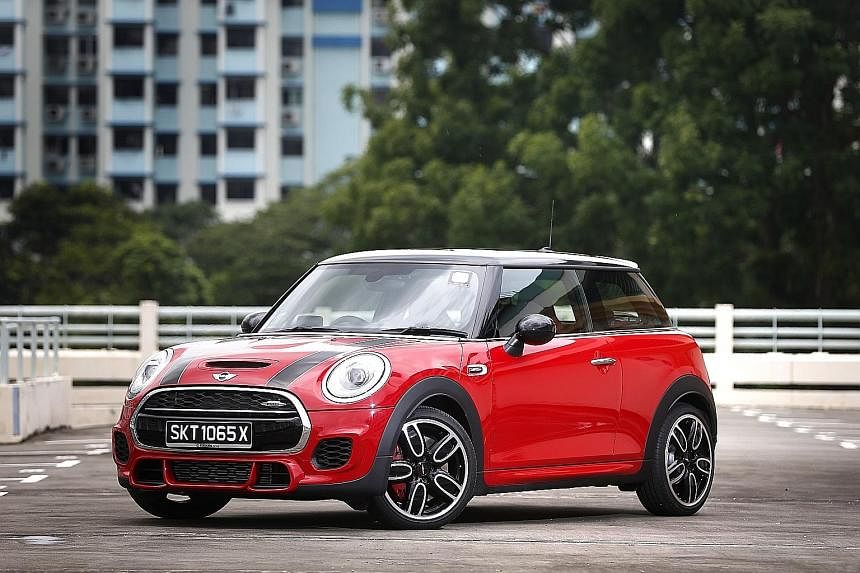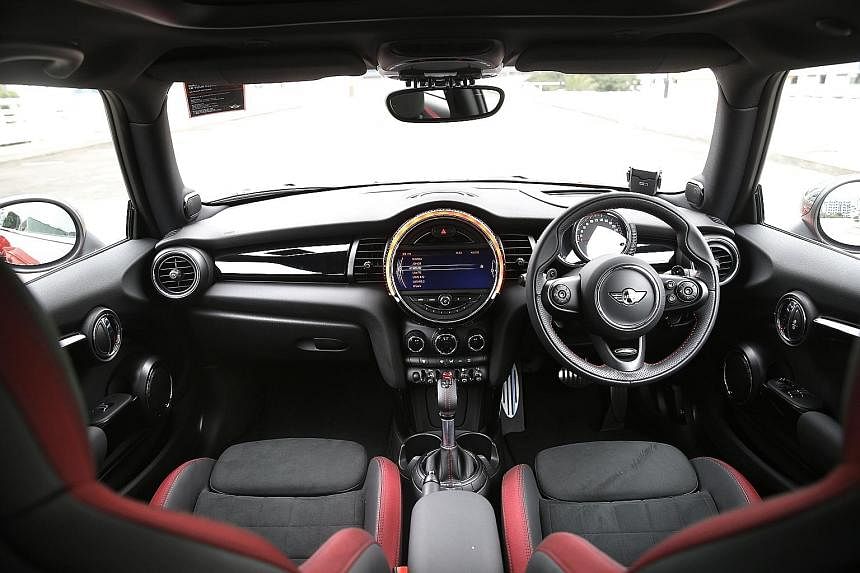-
Specs
-
MINI JOHN COOPER WORKS
Price: $205,300 with COE
Engine: 1,998cc 16-valve inline-4 turbocharged
Transmission: Six-speed automatic with paddle shift
Power: 231bhp at 5,200rpm
Torque: 320Nm at 1,250-4,800rpm
0-100kmh: 6.1 seconds
Top speed: 246kmh
Fuel consumption: 5.9 litres/100km
Agent: Eurokars Habitat
The new Mini John Cooper Works is the most powerful Mini to date, boasting 231bhp and 320Nm of tarmac-tearing torque.
But surprisingly, it does not present itself like a steroidal scorcher. Quite unlike previous JCW cars tested, the new car is a stealthy speeder, gathering velocity in an uncharacteristically refined, unobtrusive manner.
Which is just as well that it comes with a head-up display. Otherwise, you would be chalking up demerit points faster than a serial bus-lane offender.
The set-up suits the street situation in Singapore too. Rather than the loud and high-strung numbers that keep you on edge because they are unable to stretch their legs in this tiny city of one million vehicles, the Mini glides effortlessly between stops.
As a result, you are able to remain relaxed even if the car is in sport mode and you are flooring the pedal to test its claimed 6.1-second century sprint.
That figure, by the way, ends the perennial tussle between this BMW- owned British pocket rocket and Volkswagen's Golf GTI convincingly. Its arch rival, also a 2-litre front-wheeldriven sizzler, takes 6.5 seconds to reach 100kmh from zero.
The Mini has a quick-acting speedsensitive steering that stops short of being twitchy. And for the first time, shift paddles behind the wheel are sizeable and hence easier to use.
Also for the first time, you are able to choose between having the drivetrain in sport mode or the chassis, or both.
The other pertinent change lies within the engine. Its turbocharger is now integrated with the exhaust manifold, allowing its turbines more immediate access to exhaust gases.
Stopping power is now courtesy of four-piston Brembo brakes.
Even if you tick sport mode for drivetrain and chassis, the car is easy to live with as a daily commute. The ride is decidedly firm, but not punishing. And throttle response and gear changes remain usable even in stop-start traffic.
Rather than short, sharp bursts, acceleration flows like water from a tap. The progression from trickle to full gush is linear and highly responsive to changes in pedal pressure.
And even though the car is equipped with sizeble twin tailpipes that poke out from the centre of an elaborate diffuser assembly, you are not assaulted by exaggerated boom and crackle. Instead, a bassy burble resonates in the background - more audible to bystanders than to occupants in the car.
Still, it is amazing how quickly speed piles up. Before you know it, it is near the three-digit territory - even if you suspect the speedometer is sometimes a tad optimistic, going by the vehicles around you.
You don't have to take your eyes off the road to check how fast the car is going. With head-up display - the first time it is offered as a standard issue feature - the digits are always in your line of sight.
Other premium features you will find include navigation, a sunroof and Alcantara-type bucket seats.
Driving aids include dynamic stability control, dynamic traction control and electronic differential lock control. Then, there is Performance Control, which aids high-speed cornering. And Torque Steer Compensation, which mitigates the tendency of a high-powered front-wheel- driven car from veering involuntarily when peak power is applied.
But they all seem to lie dormant. Perhaps it has to do with the wushu-like fluidity of the car. Because it is so smooth and predictable, it is also highly controllable.
There is nary an overcooked situation that warrants electronic intervention. At the same time, you rarely have to pull your punches. The car's inherently sturdy chassis and well-mapped drivetrain allow you to take a few liberties you would not contemplate otherwise.
It is, therefore, quite believable that this firecracker is about 20 per cent more fuel-efficient than its predecessor, despite being quicker and more powerful.
The only thing that has not changed completely is Mini's inability to weed out cabin rattle, even when it is, on the whole, a better built car than its predecessor.
If the company is able to address this niggle, it will close another gap that exists between the JCW and the GTI.


